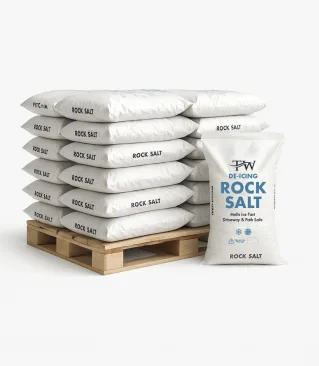Understanding the Effects of De-Icing Salt on Different Surfaces
Rock salt is one of the most effective and economical methods for keeping surfaces ice-free during winter. However, many property owners and facilities managers ask the same question each year:
💭 “Will rock salt damage my concrete or tarmac?”
The short answer is: rock salt is safe for most outdoor surfaces when used correctly, but overuse, poor drainage, or repeated freeze–thaw cycles can lead to wear over time.
Let’s break down how it works, what risks exist, and how to apply it safely.
⚙️ How Rock Salt Works on Surfaces
Rock salt (sodium chloride, NaCl) melts ice by lowering the freezing point of water, forming a brine solution that prevents refreezing.
When applied to porous surfaces like concrete, this brine can occasionally seep into tiny cracks or pores. During repeated freeze–thaw cycles, expansion of trapped water can cause surface flaking (spalling) or micro-cracking — not because of the salt itself, but due to moisture and temperature changes.
🧱 Effects on Concrete
Concrete is generally durable, but newly laid or poor-quality concrete is more vulnerable.
⚠️ Potential Risks:
- Surface Scaling or Spalling: Occurs when brine penetrates small pores and re-freezes.
- Increased Moisture Absorption: Over time, can weaken unsealed or low-grade concrete.
- Accelerated Corrosion of Reinforcement: In reinforced concrete, chloride ions may contribute to corrosion if not sealed.
✅ Best Practices:
- Avoid applying salt to new concrete (less than 12 months old)
- Use moderate quantities — more salt doesn’t equal more melting
- Seal concrete with a quality surface sealer to reduce porosity
- Brush or rinse excess salt away after the season
💡 Tip: Well-cured, sealed, exterior-grade concrete typically tolerates seasonal gritting with minimal risk.
🛣️ Effects on Tarmac (Asphalt)
Tarmac (bituminous asphalt) is less porous than concrete and generally more resistant to salt-related damage.
✅ Benefits:
- Salt helps prevent surface frost and reduces cracking by limiting ice expansion
- Brown rock salt adds traction and visibility for vehicles
⚠️ Caution:
- Avoid excessive piling of salt in one spot (can soften tar in older surfaces)
- Ensure good drainage to stop standing brine, which can weaken edges over time
🧭 Tip: Proper spreading and sweeping after winter help maintain surface integrity.
🧂 Choosing the Right Salt
| Surface | Recommended Salt | Notes |
|---|---|---|
| Concrete (sealed) | ⚪ White Rock Salt | Clean finish, minimal residue |
| Concrete (new/unsealed) | 🟤 Brown Rock Salt (light use) | Use sparingly; avoid on fresh concrete |
| Tarmac / Asphalt | ⚪ or 🟤 | Both suitable; ensure even coverage |
Both white and brown rock salt work well, but white salt is preferred in areas where cleanliness and minimal residue are priorities.
🔍 Summary
- Rock salt itself does not chemically damage concrete or tarmac.
- Physical damage can occur from freeze–thaw cycles and overuse.
- Protect surfaces with sealants, good drainage, and correct application rates.
- Avoid using on newly laid concrete until fully cured (12 months).
Used responsibly, rock salt remains one of the most effective and surface-safe methods for winter de-icing.






